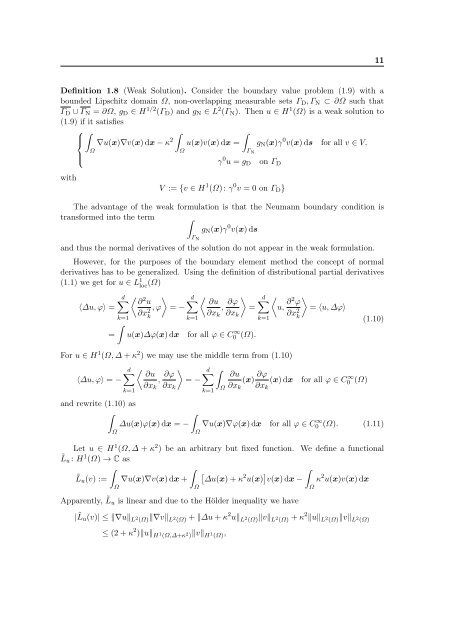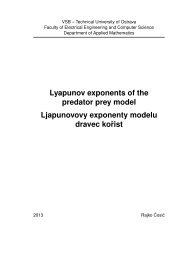The Boundary Element Method for the Helmholtz Equation ... - FEI VÅ B
The Boundary Element Method for the Helmholtz Equation ... - FEI VÅ B
The Boundary Element Method for the Helmholtz Equation ... - FEI VÅ B
Create successful ePaper yourself
Turn your PDF publications into a flip-book with our unique Google optimized e-Paper software.
11Definition 1.8 (Weak Solution). Consider <strong>the</strong> boundary value problem (1.9) with abounded Lipschitz domain Ω, non-overlapping measurable sets Γ D , Γ N ⊂ ∂Ω such thatΓ D ∪ Γ N = ∂Ω, g D ∈ H 1/2 (Γ D ) and g N ∈ L 2 (Γ N ). <strong>The</strong>n u ∈ H 1 (Ω) is a weak solution to(1.9) if it satisfies⎧ ⎪⎨ ∇u(x)∇v(x) dx − κ 2 u(x)v(x) dx = g N (x)γ 0 v(x) ds <strong>for</strong> all v ∈ V,ΩΩΓ N⎪⎩γ 0 u = g D on Γ DwithV := {v ∈ H 1 (Ω): γ 0 v = 0 on Γ D }<strong>The</strong> advantage of <strong>the</strong> weak <strong>for</strong>mulation is that <strong>the</strong> Neumann boundary condition istrans<strong>for</strong>med into <strong>the</strong> term Γ Ng N (x)γ 0 v(x) dsand thus <strong>the</strong> normal derivatives of <strong>the</strong> solution do not appear in <strong>the</strong> weak <strong>for</strong>mulation.However, <strong>for</strong> <strong>the</strong> purposes of <strong>the</strong> boundary element method <strong>the</strong> concept of normalderivatives has to be generalized. Using <strong>the</strong> definition of distributional partial derivatives(1.1) we get <strong>for</strong> u ∈ L 1 loc (Ω)d ∂ 2 ud ∂u⟨∆u, ϕ⟩ =∂x 2 , ϕ = − , ∂ϕ =k=1 k∂x k ∂x kk=1= u(x)∆ϕ(x) dx <strong>for</strong> all ϕ ∈ C0 ∞ (Ω).dk=1For u ∈ H 1 (Ω, ∆ + κ 2 ) we may use <strong>the</strong> middle term from (1.10)⟨∆u, ϕ⟩ = −dk=1 ∂u, ∂ϕ = −∂x k ∂x kand rewrite (1.10) as∆u(x)ϕ(x) dx = −ΩΩdk=1Ω∂u(x) ∂ϕ (x) dx∂x k ∂x k u, ∂2 ϕ∂x 2 = ⟨u, ∆ϕ⟩k<strong>for</strong> all ϕ ∈ C ∞ 0 (Ω)(1.10)∇u(x)∇ϕ(x) dx <strong>for</strong> all ϕ ∈ C ∞ 0 (Ω). (1.11)Let u ∈ H 1 (Ω, ∆ + κ 2 ) be an arbitrary but fixed function. We define a functional˜L u : H 1 (Ω) → C as˜L u (v) := ∇u(x)∇v(x) dx + ∆u(x) + κ 2 u(x) v(x) dx − κ 2 u(x)v(x) dxΩΩΩApparently, ˜L u is linear and due to <strong>the</strong> Hölder inequality we have|˜L u (v)| ≤ ∥∇u∥ L 2 (Ω)∥∇v∥ L 2 (Ω) + ∥∆u + κ 2 u∥ L 2 (Ω)∥v∥ L 2 (Ω) + κ 2 ∥u∥ L 2 (Ω)∥v∥ L 2 (Ω)≤ (2 + κ 2 )∥u∥ H 1 (Ω,∆+κ 2 )∥v∥ H 1 (Ω),









